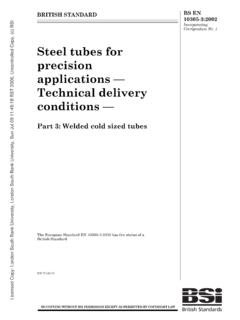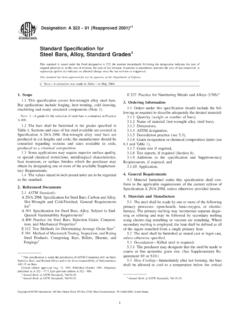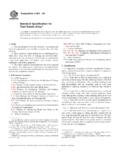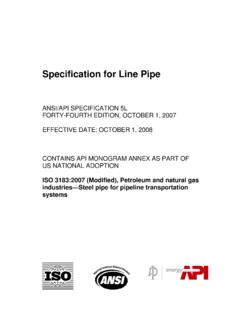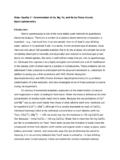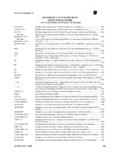Transcription of Standard Specification for High-Carbon Anti …
1 Designation: A 295 98An American National StandardStandard Specification forHigh- carbon anti -Friction Bearing Steel1 This Standard is issued under the fixed designation A 295; the number immediately following the designation indicates the year oforiginal adoption or, in the case of revision, the year of last revision. A number in parentheses indicates the year of last reapproval. Asuperscript epsilon (e) indicates an editorial change since the last revision or Standard has been approved for use by agencies of the Department of This specification covers High-Carbon bearing-qualitysteel to be used in the manufacture of anti -friction Supplementary requirements of an optional nature areprovided and when desired shall be so stated in the The values stated in inch-pound units are to be regardedas the Referenced standards .
2 A 29/A 29M Specification for Steel Bars, carbon andAlloy, Hot-Wrought and Cold-Finished, General Require-ments for2A 370 Test Methods and Definitions for Mechanical Testingof Steel Products3A 751 Test Methods, Practices, and Terminology forChemical Analysis of Steel Products3A 892 Guide for Defining and Rating the Microstructure ofHigh carbon Bearing Steels2E 45 Practice for Determining the Inclusion Content ofSteel4E 381 Method of Macroetch Testing, Inspection, and RatingSteel Products, Comprising Bars, Billets, Blooms, andForgings4E 1019 Test Methods for Determination of carbon , Sulfur,Nitrogen, Oxygen, and Hydrogen in Steel and in Iron,Nickel, and Cobalt Alloys5E 1077 Test Method for Estimating the Depth of Decarbur-ization of Steel Documents:SAE J418a Grain Size Determination of Steel6 ISO 683, Part 17 Ball and Roller Bearing Steels73.
3 Ordering Orders for material under this specification shouldinclude the following Quantity, Grade identification, Specification designation and year of issue, Dimensions, Supplementary requirements, if The steel shall be made by a process that is capable ofproviding a high quality product meeting the requirements ofthis Chemical Composition and Typical examples of chemical compositions are shownin Table 1. Other compositions may be An analysis of each heat of steel shall be made by thesteel manufacturer in accordance with Test Methods, Practices,and Terminology A 751.
4 The chemical composition thus deter-mined shall conform to the requirements specified in Table 1for the ordered grade or to other requirements agreed uponbetween manufacturer and Product analysis may be made by the purchaser inaccordance with Test Methods, Practices, and TerminologyA 751. Permissible variations in product analysis shall be inaccordance with Specification A 29/A Sizes, Shapes, and Dimensional The physical size and shape of the material shall beagreed upon between manufacturer and Dimensional tolerances for hot-rolled or hot-rolled andannealed bars, in straight lengths or coils, and cold-finishedbars in.
5 ( mm) and larger in diameter furnished underthis specification shall conform to the requirements specified inthe latest edition of Specification A 29 Dimensional tolerances for cold-finished coils for balland roller material shall be as shown in Table Coil tolerances also apply to cold-finished straightlengths under in. in Quality The supplier shall be held responsible for the quality ofthe material furnished and shall make the necessary tests to1 This specification is under the jurisdiction of ASTM Committee A-1 on Steel,Stainless Steel and Related Alloys, and is the direct responsibility of on Bearing edition approved Dec.
6 10, 1998. Published February 1999. Originallypublished as A 295 46 T. Last previous edition A 295 Book of ASTM standards , Vol Book of ASTM standards , Vol Book of ASTM standards , Vol Book of ASTM standards ,Vol from Society of Automotive Engineers, 400 Commonwealth Drive,Warrendale, PA from International Organization for Standardization (ISO), 1 rue deVaremb , Case postale 56, CH-1211, Gen ve 20, SOCIETY FOR TESTING AND MATERIALS100 Barr Harbor Dr., West Conshohocken, PA 19428 Reprinted from the Annual Book of ASTM standards .
7 Copyright ASTM ensure this quality. The supplier shall be required to reportresults of the macroetch and micro-inclusion rating testsdetailed below. Quality tests shown in through arebased upon procedures established in Practice E Samples taken in accordance with the fol-lowing paragraphs shall be obtained from 4 by 4-in. (102 by102-mm) rolled billets or forged sections. Tests may be madeon smaller or larger sections by agreement between manufac-turer and purchaser. A minimum 3 to 1 reduction of rolledbillets or forged sections is required for strand cast For top poured products, a minimum of six samplesrepresenting the top and bottom of the first, middle, and lastusable ingots shall be For bottom poured products, a minimum of sixsamples shall be examined and they shall represent the top andbottom of three ingots.
8 One ingot shall be taken at randomfrom the first usable plate poured, one ingot, at random, fromthe usable plate poured nearest to the middle of the heat, andone ingot, at random, from the last usable plate poured. Whentwo usable plates constitute a heat, two of the sample ingotsshall be selected from the second usable plate poured. Where asingle usable plate constitutes a heat, any three random ingotsmay be selected. Other methods of sampling shall be as agreedupon between manufacturer and For strand cast products, a minimum of six samplesrepresenting the first, middle, and last portion of the heat castshall be examined.
9 At least one sample shall be taken fromeach Specimens representative of cross sectionsof billets shall be macroetched and rated in accordance withMethod E 381 in hydrochloric acid and water (1:1) at 160 to180 F (71 to 82 C). Such specimens shall not exceed S2, R2,and C2 of Method E Rating The specimens shall be3 8by3 4in.( by mm) and shall be taken from an area halfwaybetween the center and outside of the billet. The polished faceshall be longitudinal to the direction of rolling. The scale usedfor rating the specimens shall be the Jernkontoret chartdescribed in Practice E 45, Plate I-r.
10 Fields with sizes ornumbers of all types of inclusions intermediate betweenconfigurations shown on the chart shall be classified as thelesser of the rating number. The worst field of each inclusiontype from each specimen shall be recorded as the rating for thespecimen. Two thirds of all specimens and at least one fromeach ingot tested, or from the first, middle, and last portion ofthe strands tested, as well as the average of all specimens, shallnot exceed the rating specified in Table 3. If specificallyordered and certified to Supplementary Requirement S4, TypeA inclusion ratings shall not exceed thin and heavy.
